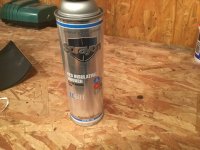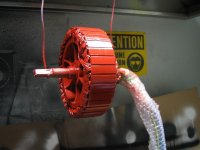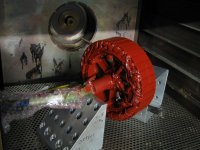Doctorbass
100 GW
Hello Guys,
Yes!.. why this is so important....
Well curiously i'm preparing the motor for my 2nd NYX that i'm building for the friends that will visit me... and the reason why i'm actually protecting that future motor, is to avoid exactly the one like a motor i got to repair that at first had apparently a problem of shorted wires, but when i opened it i was all that rust!!!
So there are ALOT good reasons why you should add protection to the inside of our motor!.. when your ebike is exposed to rain, it will one day or another be affected by water intrusion and results often the lost of your motor or require several hours to repair the damages. on the other hand if you apply the proper coating inside it will prevent rust and make your great motor to last longer! I have 10 years of experience in ebike diy and this advice will save you money and extend your ebike motor life!
THE MOTOR PROTECTIVE COATING PRODUCT i use: SPRAYON EL601
WHERE TO BUY:https://www.sprayon.com/where-to-buy/
I only use one brand as this is the most popular and professional product i have acces to. It is SPECIALY made for that purpose and is specialy formuled to wistand the worst environment. In Canada we develop and produce alot of motor and transformer in different brands and the Sprayon is the product the most availlable/popular. The actual version i use is the EL601. It is a epoxy based coating.
SPECS:
Dielectritic Strength: 2,600VPM
Dielectric Strength: 2,600 Volts per Meter
NEMA & UL Temperature Class
310°F / 155°C
National Electrical Manufacturers Association (NEMA) & Underwriters Laboratories (UL) Temperature Class: F (310°F/155°C) Maximum Hot Spot Temperature Allowed
Color: Red
Nozzle Type: EZ-Touch™ for superior coverage and control with a conical spray
HMIS Rating: 2,4,0
Hazardous Materials Identification System (HMIS) Rating: Health - 2, Flammability - 4, Reactivity - 0
At a Glance
•Air dries In 10 minutes
•Meets NEMA & UL Class F Requirements
•Resists oil, moisture, acids and alkalis
•Meets performance requirements of ASTM D115-07 4.2
Uses :
Small field and magnet coils, motor windings, field coils, transformers, armatures, commutator ends, stator windings, ring and frames, bus bars, sealing electrical, switchboard parts and electronic components.
% Solids = 0.228%
% VOC = 0.5517%
Base Type = Phenolic Epoxy
Color = Red
Consistency = Liquid
Dielectric Strength = 2600Volts
Evaporation Rate = Fast
Film Type = Semi-Solid
Flammable = Yes
Flashpoint = <0°F
HMIS Rating = 2,4,0
Plastic Safe = No
Propellant = Hydrocarbon
Sheen = Semi-Gloss
Specific Gravity = 0.79
Spray Pattern = Danvern
Temp High = 400°F
Temp Low = 310°F
Temperature Class = Class F (155°C / 310°)
See more at: https://www.sprayon.com/product-categories/electrical-and-electronic-cleaners-and-degreasers/red-insulating-varnish-aerosol-el601#sthash.u2KncnEB.dpuf
https://www.sprayon.com/product-cat...greasers/red-insulating-varnish-aerosol-el601
I attached pictures of my current motor being prepared for the protection... and also pictures of my friend's motor that was completly jammed inside due to ALOT of rust!.. and the motor is nearly not repairrable due to the dammage to the magnets... this is difficult to describe HOW MUCH FORCE MY AXEL PULLER had to apply force on the axel to push the stator out of the rotor !!! even with both perfectly aligned and guided axially...
If these pictures can not convince you then nothing else can!! :wink:
[youtube]1UmA5xmzgsM[/youtube]
Doc
Yes!.. why this is so important....
Well curiously i'm preparing the motor for my 2nd NYX that i'm building for the friends that will visit me... and the reason why i'm actually protecting that future motor, is to avoid exactly the one like a motor i got to repair that at first had apparently a problem of shorted wires, but when i opened it i was all that rust!!!
So there are ALOT good reasons why you should add protection to the inside of our motor!.. when your ebike is exposed to rain, it will one day or another be affected by water intrusion and results often the lost of your motor or require several hours to repair the damages. on the other hand if you apply the proper coating inside it will prevent rust and make your great motor to last longer! I have 10 years of experience in ebike diy and this advice will save you money and extend your ebike motor life!
THE MOTOR PROTECTIVE COATING PRODUCT i use: SPRAYON EL601
WHERE TO BUY:https://www.sprayon.com/where-to-buy/
I only use one brand as this is the most popular and professional product i have acces to. It is SPECIALY made for that purpose and is specialy formuled to wistand the worst environment. In Canada we develop and produce alot of motor and transformer in different brands and the Sprayon is the product the most availlable/popular. The actual version i use is the EL601. It is a epoxy based coating.
SPECS:
Dielectritic Strength: 2,600VPM
Dielectric Strength: 2,600 Volts per Meter
NEMA & UL Temperature Class
310°F / 155°C
National Electrical Manufacturers Association (NEMA) & Underwriters Laboratories (UL) Temperature Class: F (310°F/155°C) Maximum Hot Spot Temperature Allowed
Color: Red
Nozzle Type: EZ-Touch™ for superior coverage and control with a conical spray
HMIS Rating: 2,4,0
Hazardous Materials Identification System (HMIS) Rating: Health - 2, Flammability - 4, Reactivity - 0
At a Glance
•Air dries In 10 minutes
•Meets NEMA & UL Class F Requirements
•Resists oil, moisture, acids and alkalis
•Meets performance requirements of ASTM D115-07 4.2
Uses :
Small field and magnet coils, motor windings, field coils, transformers, armatures, commutator ends, stator windings, ring and frames, bus bars, sealing electrical, switchboard parts and electronic components.
% Solids = 0.228%
% VOC = 0.5517%
Base Type = Phenolic Epoxy
Color = Red
Consistency = Liquid
Dielectric Strength = 2600Volts
Evaporation Rate = Fast
Film Type = Semi-Solid
Flammable = Yes
Flashpoint = <0°F
HMIS Rating = 2,4,0
Plastic Safe = No
Propellant = Hydrocarbon
Sheen = Semi-Gloss
Specific Gravity = 0.79
Spray Pattern = Danvern
Temp High = 400°F
Temp Low = 310°F
Temperature Class = Class F (155°C / 310°)
See more at: https://www.sprayon.com/product-categories/electrical-and-electronic-cleaners-and-degreasers/red-insulating-varnish-aerosol-el601#sthash.u2KncnEB.dpuf
https://www.sprayon.com/product-cat...greasers/red-insulating-varnish-aerosol-el601
I attached pictures of my current motor being prepared for the protection... and also pictures of my friend's motor that was completly jammed inside due to ALOT of rust!.. and the motor is nearly not repairrable due to the dammage to the magnets... this is difficult to describe HOW MUCH FORCE MY AXEL PULLER had to apply force on the axel to push the stator out of the rotor !!! even with both perfectly aligned and guided axially...
If these pictures can not convince you then nothing else can!! :wink:
[youtube]1UmA5xmzgsM[/youtube]
Doc
Attachments
-
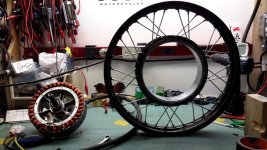 20170312_192752 (Personnalisé).jpg133.8 KB · Views: 7,374
20170312_192752 (Personnalisé).jpg133.8 KB · Views: 7,374 -
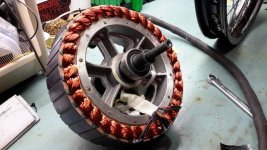 20170312_192804 (Personnalisé).jpg127.3 KB · Views: 7,371
20170312_192804 (Personnalisé).jpg127.3 KB · Views: 7,371 -
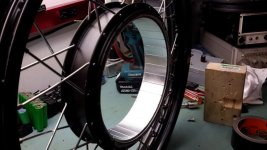 20170312_192810 (Personnalisé).jpg98.8 KB · Views: 7,373
20170312_192810 (Personnalisé).jpg98.8 KB · Views: 7,373 -
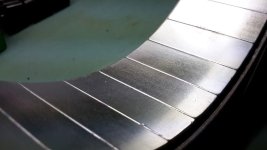 20170312_192818 (Personnalisé).jpg64.9 KB · Views: 7,371
20170312_192818 (Personnalisé).jpg64.9 KB · Views: 7,371 -
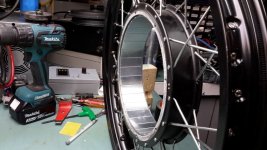 20170312_192828 (Personnalisé).jpg114.4 KB · Views: 7,371
20170312_192828 (Personnalisé).jpg114.4 KB · Views: 7,371 -
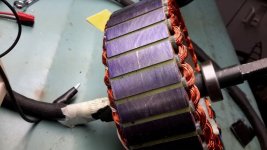 20170312_192836 (Personnalisé).jpg95.1 KB · Views: 7,373
20170312_192836 (Personnalisé).jpg95.1 KB · Views: 7,373 -
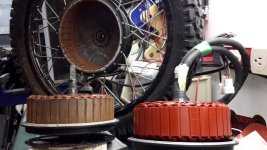 20170324_001647 (Personnalisé).jpg123.4 KB · Views: 7,376
20170324_001647 (Personnalisé).jpg123.4 KB · Views: 7,376 -
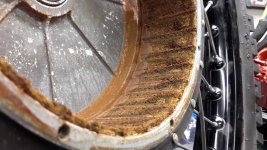 20170324_001709 (Personnalisé).jpg80.6 KB · Views: 7,373
20170324_001709 (Personnalisé).jpg80.6 KB · Views: 7,373 -
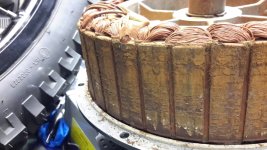 20170324_001721 (Personnalisé).jpg76.4 KB · Views: 7,373
20170324_001721 (Personnalisé).jpg76.4 KB · Views: 7,373


